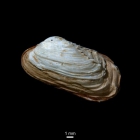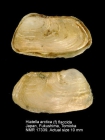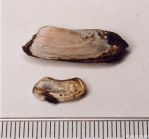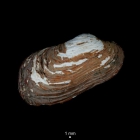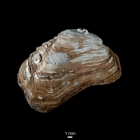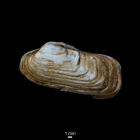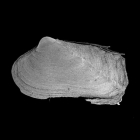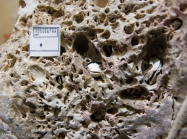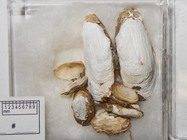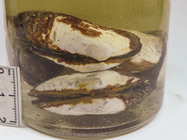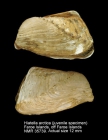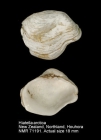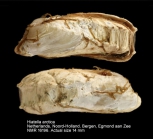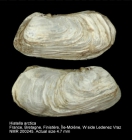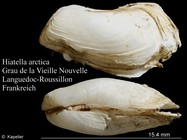
| Introduction | | Search taxa | | Taxon tree | | Taxon match | | Checklist | | Literature | | Stats | | Photogallery | | OBIS Vocab | | Log in |
CaRMS taxon detailsHiatella Bosc, 1801
138068 (urn:lsid:marinespecies.org:taxname:138068)
accepted
Genus
marine
Bosc, L. A. G. (1801). Histoire naturelle des coquilles, contenant leur description, les moeurs des animaux qui les habitent et leurs usages. <em>Deterville, Paris.</em> vol. 1, 343 p.; vol. 2, 330 p.; vol. 3, 292 p.; vol. 4, 280 p.; vol. 5, 255 p., 1 table, 44 plates., available online at http://www.biodiversitylibrary.org/bibliography/10436 [details]
Taxonomy Recent research has shown that living members of the genus Hiatella are genetically diverse. The nestling habitat of this...
Taxonomy Recent research has shown that living members of the genus Hiatella are genetically diverse. The nestling habitat of this genus results in an extremely variable shell morphology. That nestling can occur among epibionts on boats and floating debris suggests that transport of some genetic entities has occurred for centuries. It may thus be difficult or impossible to correlate shell morphologies with genetic entities, particularly with the many nominal species described since 1758 based solely on shells. An entirely new classification may be needed for this difficult genus, and some authors are now using letters, such as "Hiatella sp. J" to indicate genetic entities. [details]
MolluscaBase eds. (2024). MolluscaBase. Hiatella Bosc, 1801. Accessed through: Nozères, C., Kennedy, M.K. (Eds.) (2024) Canadian Register of Marine Species at: https://www.marinespecies.org/Carms/aphia.php?p=taxdetails&id=138068 on 2024-04-16
Nozères, C., Kennedy, M.K. (Eds.) (2024). Canadian Register of Marine Species. Hiatella Bosc, 1801. Accessed at: https://marinespecies.org/carms/aphia.php?p=taxdetails&id=138068 on 2024-04-16
Date action by
original description
Bosc, L. A. G. (1801). Histoire naturelle des coquilles, contenant leur description, les moeurs des animaux qui les habitent et leurs usages. <em>Deterville, Paris.</em> vol. 1, 343 p.; vol. 2, 330 p.; vol. 3, 292 p.; vol. 4, 280 p.; vol. 5, 255 p., 1 table, 44 plates., available online at http://www.biodiversitylibrary.org/bibliography/10436 [details]
context source (PeRMS) Paredes, C.; Cardoso, F.; Santamaría, J.; Esplana, J.; Llaja, L. (2016). Lista anotada de los bivalvos marinos del Perú. <em>Revista peruana de biología.</em> 23(2), 127-150., available online at http://www.scielo.org.pe/scielo.php?script=sci_arttext&pid=S1727-99332016000200006 [details] redescription Coan, E. V.; Valentich-Scott, P. (2012). Bivalve seashells of tropical West America. Marine bivalve mollusks from Baja California to northern Peru. 2 vols, 1258 pp. [details] status source Laakkonen, H. M., Strelkov, P. & Väinölä, R. (2016). Molecular lineage diversity and inter-oceanic biogeographical history in Hiatella (Mollusca, Bivalvia). <em>Zoologica Scripta 44: 383-402.</em> [details] Available for editors subsequent type designation Winckworth, R. (1932). The British marine Mollusca. <em>Journal of Conchology.</em> 19 (7): 211-252. [details] Available for editors  Present Present  Inaccurate Inaccurate  Introduced: alien Introduced: alien  Containing type locality Containing type locality
From editor or global species database
Taxonomy Recent research has shown that living members of the genus Hiatella are genetically diverse. The nestling habitat of this genus results in an extremely variable shell morphology. That nestling can occur among epibionts on boats and floating debris suggests that transport of some genetic entities has occurred for centuries. It may thus be difficult or impossible to correlate shell morphologies with genetic entities, particularly with the many nominal species described since 1758 based solely on shells. An entirely new classification may be needed for this difficult genus, and some authors are now using letters, such as "Hiatella sp. J" to indicate genetic entities. [details]
From editor or global species database
From other sources
|
